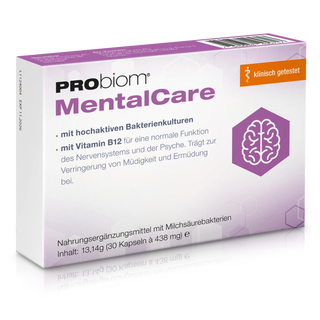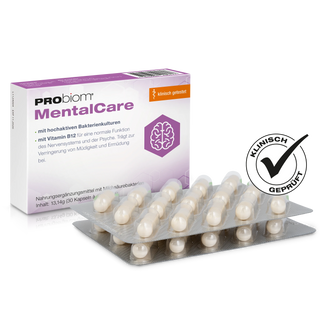A healthy body is home to trillions of microorganisms – including fungi like Candida albicans . In small quantities, this yeast fungus performs beneficial functions in the digestive tract, on the skin, and in the mucous membranes. However, it becomes problematic when Candida albicans multiplies uncontrollably. Then a harmless roommate can become a serious nuisance.
An overgrowth of Candida albicans , also known as candidiasis, can cause a variety of symptoms – from bloating, diarrhea, and sugar cravings to chronic fatigue, skin problems, and recurring vaginal infections. The connection between Candida and general health problems has been discussed in naturopathy for years – and is increasingly being investigated in scientific studies.
In this article, we will examine what is behind Candida overgrowth, how symptoms manifest themselves, what the underlying causes may be, and how to naturally bring Candida albicans back into balance.
What is Candida Albicans?
Candida albicans is a yeast fungus that belongs to the natural flora of the human body. It lives in a healthy balance with other microorganisms in the intestines, on the skin, and mucous membranes. Only when this balance is disturbed—for example, by antibiotics, excess sugar, or a weakened immune system—does the fungus begin to proliferate rapidly.
Unlike other fungi, Candida albicans has the ability to adapt to different living conditions. It can transform from a harmless round fungus to an invasive thread-like form, penetrate tissue, and trigger inflammation. This is particularly problematic in cases of weakened immune systems.
How does Candida overgrowth manifest itself?
The symptoms of a Candida infection are often nonspecific and can affect various organ systems. They are often overlooked or mistakenly attributed to other causes.
Typical complaints can be:
-
Digestive problems such as bloating, fullness, diarrhea or constipation
-
Strong cravings for sugar or white flour products
-
Common vaginal yeast infections in women
-
Skin problems (eczema, itching, rashes)
-
Chronic fatigue and concentration problems (“brain fog”)
-
Mood swings, irritability, depressive moods
-
Oral thrush (white coating on the tongue and mucous membranes)
Important: These symptoms can also have other causes. Therefore, medical evaluation is always advisable.
Causes: Why does Candida become unbalanced?
A variety of factors can promote the growth of Candida albicans . A combination of several triggers is particularly common.
-
Antibiotics
Broad-spectrum antibiotics not only destroy pathogenic bacteria, but also beneficial intestinal bacteria. This promotes the growth of yeasts like Candida , which can then spread unhindered. -
High-sugar diet
Candida albicans prefers simple carbohydrates and sugar. A diet high in sugar therefore acts like a fertilizer for the fungus. -
Weakened immune system
Chronic stress, lack of sleep or pre-existing conditions such as diabetes mellitus can weaken the immune system and promote overgrowth. -
Hormonal changes
Hormonal fluctuations – for example due to pregnancy, taking the pill or hormone therapy – can disrupt the balance of the mucous membranes and promote Candida infections. -
Disturbance of the intestinal flora (dysbiosis)
An imbalance in the microbiome due to malnutrition, environmental toxins or medication weakens the natural barrier function of the intestine and opens the door to Candida .
How is Candida diagnosed?
A reliable diagnosis can be made using various methods. Common methods include:
-
Stool examination: The detection of Candida yeast in the stool indicates intestinal colonization.
-
Swabs: In the case of local infections (e.g. vagina, mouth), a swab can provide information.
-
Blood tests: In special cases (e.g. systemic candidiasis), antibody or antigen detection in the blood may be useful.
The interpretation of such tests should always be carried out by medical professionals, since Candida can also be detected in healthy people without being relevant to disease.
Holistic approaches to treating Candida
Successful treatment aims not only at reducing the fungus, but also at restoring microbial balance and intestinal health.
Nutrition as key
The so-called “anti-Candida diet” relies on:
-
Avoid sugar, alcohol, white flour products, yeast and highly processed foods
-
Focus on fiber-rich, natural foods (e.g. vegetables, whole grains, legumes)
-
Integration of antifungal foods such as garlic, coconut oil, cinnamon or oregano
The diet should be individually adapted and as nutrient-rich as possible – long-term malnutrition is counterproductive.
Probiotics and intestinal health
Since a disturbed intestinal flora is a key factor in Candida overgrowth, rebuilding a healthy microbiome plays a crucial role. Probiotics can help establish beneficial bacteria that naturally regulate fungal growth. Prebiotic fiber—the "food" for good intestinal bacteria—also promotes microbial balance.
Antifungal therapy
In severe cases or in cases of localized infections, conventional antifungal medications (e.g., nystatin, fluconazole) are also used. However, these should always be prescribed and supervised by a doctor.
Lifestyle and immune system
A strong body is the best defense against fungal overgrowth. Adequate sleep, stress reduction, exercise, and careful use of medications (e.g., antibiotics) are important components of any Candida therapy.
Candida and the microbiome – a complex relationship
The interaction between Candida albicans and the bacteria of the microbiome is complex. A healthy gut with a diverse bacterial population can control fungal growth. However, if the balance is disturbed, Candida has an easy time. Conversely, a Candida infection can further disrupt the intestinal environment and promote inflammatory processes.
Studies show that certain lactic acid bacteria can inhibit the growth of Candida albicans and strengthen the intestinal mucosa. Thus, promoting a stable microbiome is becoming an increasingly important focus of holistic therapy.
Conclusion: Balance Candida – don’t just fight it
Candida albicans is more than just a nuisance fungus—it's part of our internal ecosystem. Problems only arise when the microbial balance is disrupted. Treatment should therefore not only target the fungus, but also consider the underlying causes and the environment within the body.
With a gut-friendly diet, targeted microbiome support, and a healthy lifestyle, Candida overgrowth can often be successfully controlled. However, in cases of severe symptoms or chronic complaints, medical evaluation and follow-up are always necessary.


















